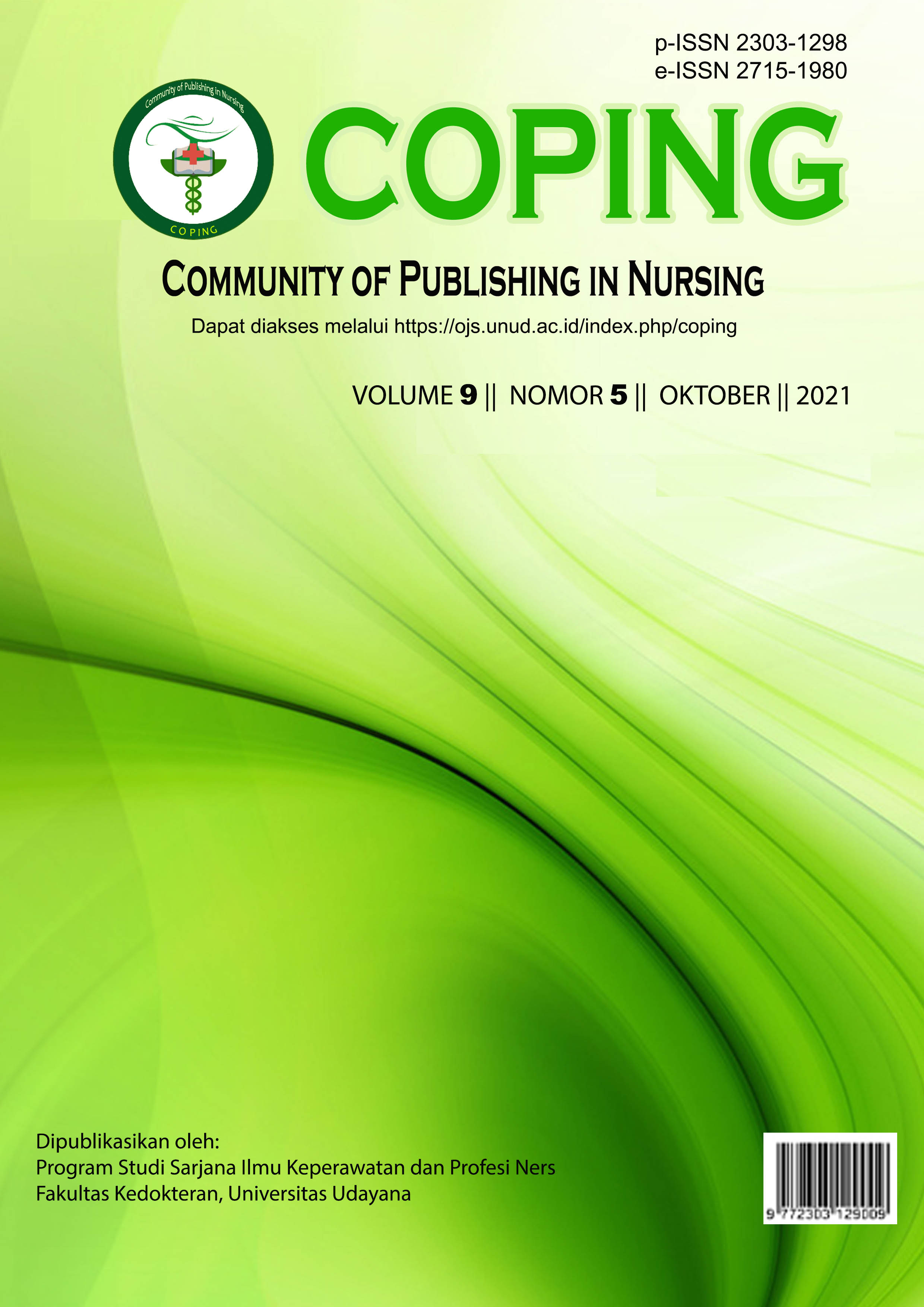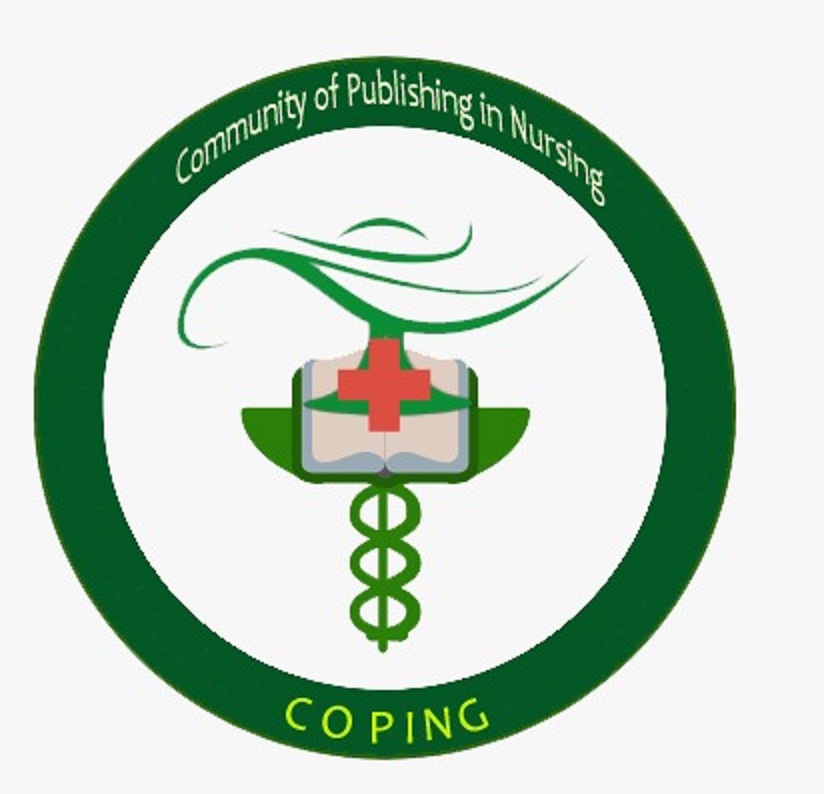HUBUNGAN TIPE KEPRIBADIAN DENGAN BURNOUT PADA MAHASISWA TAHUN PERTAMA PSSIKPN FK UNUD
Abstract
The nursing students are one of the groups that are susceptible to get stress. Uncontrolled and long-term stress could cause negative impacts, like as burnout. One of the factors that can affect burnout is personality type. Personality type are able to determine the reaction caused by stress which is impacting burnout. The aim of this study was to find out the relationship between personality type and burnout in first year nursing students of Udayana University. This study was a correlational analysis research with 70 students as the samples which was obtain by simple random sampling technique. Big Five Inventory (BFI) and Maslach Burnout Student Survey (MBI-SS) questionnaires were used as the measuring instrument. Pearson Product Moment and Spearmen Rank statistical tests were used as data analysis. The analysis result showed that based on personality type most of the respondents were in the dimension of neuroticism (67.1%). A total of 7.1% of respondents have a high category of burnout, 90.0% respondents have moderate category of burnout, and 2.9% of respondents have low category of burnout. The test analysis indicated that there was found a low positive relationship between neuroticism and burnout in first year nursing students (p = 0,041; r = 0,245). However, no significant relationship was found between openness to experience, conscientiousness, extraversion and agreeableness to burnout in first year nursing students. According to the above results, it can be concluded that personality type can be related to burnout in first year nursing students. It is highly recommended that nursing institution to develop an orientation program associated with personality type and implement a strategy to prevent burnout in students.
Downloads
References
Aguayo, R., Cañadas, G. R., Assbaa-Kaddouri, L., Cañadas-De la Fuente, G. A., Ramírez-Baena, L., & Ortega-Campos, E. (2019). A risk profile of sociodemographic factors in the onset of academic burnout syndrome in a sample of university students. International Journal of Environmental Research and Public Health, 16(5), 1–10
Alarcon, G., Eschleman, K. J., & Bowling, N. A. (2010). Relationships between personality variables and burnout : A meta-analysis. Work & Stress, 23(3), 37–41. https://doi.org/10.1080/02678370903282600
Aliftitah, S. (2015). Pengaruh Solution Focused Brief Counselling dalam mencegah Burnout Syndrome pada Mahasiswa Keperawatan. Jurnal Kesehatan “Wirajaya Medika,” 6(2), 68–77.
Alimah, S., & Swasti, K. G. (2018). Gambaran Burnout pada Mahasiswa Keperawatan di Purwokerto. Jurnal Keperawatan Soedirman, 11(2), 130–141
Allport, G. W. (1961). Personality : A Psychological Interpretation. New York : Henry Holth and Company.
Amanya, S. B., Nakitende, J., & Ngabirano, T. D. (2018). A cross-sectional study of stress and its sources among health professional students at Makerere University, Uganda. Nursing Open, 5(1), 70–76. https://doi.org/10.1002/nop2.113
American College Health Association. (2013). American College Health Association-National College Health Assessment II : Reference Group Executive Summary Fall 2013. American College Health Association.
Arlinkasari, F., & Akmal, S. Z. (2017). Hubungan antara School Engagement, Academic Self-Efficacy dan Academic Burnout pada Mahasiswa. Humanitas (Jurnal Psikologi), 1(2), 81–102. https://doi.org/10.28932/humanitas.v1i2.418
Asih, F., & Trisni, L. (2015). Hubungan Antara Kepribadian Hardiness Dengan Burnout Pada Perawat Gawat Darurat Di Rumah Sakit Pantiwilasa Citarum. Psikodimensia, 14(1), 11–23. https://doi.org/10.24167/psiko.v14i1.370
Barseli, M., & Nikmarijal, N. (2017). Jurnal Konseling dan Pendidikan Konsep Stres Akademik Siswa. Jurnal Konseling Dan Pendidikan, 5(3), 143–148.
Celik, G. T., & Oral, E. L. (2013). Burnout Levels and Personality Traits - The Case of Turkish Architectural Students. Creative Education, 04(02), 124–131. https://doi.org/10.4236/ce.2013.42018
Chai, P. P. M., Krägeloh, C. U., Shepherd, D., & Billington, R. (2012). Stress and quality of life in international and domestic university students: Cultural differences in the use of religious coping. Mental Health, Religion and Culture, 15(3), 265–277. https://doi.org/10.1080/13674676.2011.571665
Chen, W.-S., Haniff, J., Siau, C.-S., Seet, W., Loh, S.-F., Jamil, M. H. A., Sa ’at, N., & Baharum, N. (2014). Burnout in academics: An empirical study in private universities in Malaysia. The International Journal of Social Sciences and Humanities Invention, 1(2), 62–72.
Costa, P., & McCrae, R. R. (1994). Personality Disorders and The Five-Factor Model of Personality. Washington DC, USA : American Psychological Association.
Costa, P. T., & McCrae, R. R. (2003). Personality in Adulthood Secon Edition A Five Factor Theory Perspective. New York : The Guilford Press.
Silva, R. M., Goulart, C. T., Lopes, L. F. D., Serrano, P. M., Costa, A. L. S., & de Azevedo Guido, L. (2014). Hardy personality and burnout syndrome among nursing students in three Brazilian universities-an analytic study. BMC Nursing, 13(1), 1–6. https://doi.org/10.1186/1472-6955-13-9
Boni, R. A., Paiva, C. E., De Oliveira, M. A., Lucchetti, G., Fregnani, J. H. T. G., & Paiva, B. S. R. (2018). Burnout among medical students during the first years of undergraduate school: Prevalence and associated factors. PLoS ONE, 13(3), 1–15. https://doi.org/10.1371/journal.pone.0191746
Fadilah, A. E. R. (2013). Stres dan Motivasi Belajar Pada Mahasiswa Psikologi Universitas Mulawarman yang Sedang Menyusun Skripsi. EJournal Psikologi, 1(3), 254–267.
Fillhumaam, F., Nurcholis, G., & Nurahaju, R. (2019). Hubungan Stres Kerja Dan Kepribadian Dengan Burnout Pada Anak Buah Kapal (ABK) Kri “X” Tni Angkatan Laut Surabaya. Jurnal Sains Psikologi, 8(2), 199–206. https://doi.org/10.17977/um023v8i22019p199
Fitria, A. N., Putri, C. D., & Rahmah, T. (2019). Gambaran Kepribadian Mahasiswa Baru 2019. Psikologi.
Hardiyanti, R. (2013). Burnout Ditinjau dari Big Five Factors Personality pada Karyawan Kantor Pos Pusat Malang. Jurnal Ilmiah Psikologi Terapan, 01(02), 343–360.
Hidayat, D. R. (2011). Teori dan Aplikasi Psikologi Kepribadian dalam Konseling. Jakarta : Ghalia Indonesia.
Holman, A., Gavrilescu, I.-M., Muraru, I.-D., & Petrariu, F. D. (2018). Alexithymia and the Big Five Personality Traits As Predictors of Burnout Among Medical Students. Medical-Surgical Journal-Revista Medico-Chirurgicala, 122(3), 592–602.
Ijaz, T., & Ahmed, S. (2019). Suicidal Ideation and Burnout Among University Students. October, 87927. https://doi.org/10.20472/iac.2018.044.022
Labrague, L. (2013). Stress, Stressors, and Stress Responses of Student Nurses in a Government Nursing School. Health Science Journal, 7(4), 424–435.
Balkis, M. (2013). The Relationship between Academic Procrastination and Students’ Burnout. Hacettepe Üniversitesi Eğitim Fakültesi Dergisi, 28(28–1), 68–78.
Kumar, R., & Nancy, N. (2011). Stress And Coping Strategies Among Nursing Students. Nursing and Midwifery Research Journal, 7(4), 140–151. https://doi.org/10.33698/nrf0134
Maslach, C., Jackson, S. E., & Leiter, M. P. (1996). The Maslach Burnout Inventory. Palo Alto, CA : Consulting Psychologist Press.
Maslach, C., Schaufeli, W. B., & Leiter, M. P. (2001). Job Burnout. Annu. Rev. Psychol. 52 :397–422.
Opeyemi, S.-M. I. (2018). Emotional Intelligence , Academic Motivation and Self-Efficacy as Predictors of Academic Burnout Among Undergraduates in. Research Advances in Brain Disorders and Therapy, 1, 1–6. https://doi.org/10.29011/RABDT-102.
Prabhasuari, I. A. M. (2019). Survei Burnout Pada Mahasiswa Keperawatan Yang Menjalani Sistem Pembelajaran Blok Di Fakultas Kedokteran Naskah Publikasi, Universitas Udayana.
Rahmawati, S., Indriayu, M., & Sabandi, M. (2017). Pengaruh Tekanan Akademik Terhadap Prestasi Akademik Mahasiswa Pendidikan Ekonomi Fakultas Keguruan Dan Ilmu Pendidikan Universitas Sebelas Maret. Jurnal Pendidikan Ekonomi, 3(2), 1–16.
Rahmayani, R. D., Liza, R. G., & Syah, N. A. (2019). Gambaran Tingkat Stres Berdasarkan Stressor pada Mahasiswa Kedokteran Tahun Pertama Program Studi Profesi Dokter Fakultas Kedokteran Universitas Andalas Angkatan 2017. Jurnal Kesehatan Andalas, 8(1), 103. https://doi.org/10.25077/jka.v8i1.977
Salmela-Aro, K., Kiuru, N., Pietikäinen, M., & Jokela, J. (2008). Does school matter? The role of school context in adolescents’ school-related burnout. European Psychologist, 13(1), 12–23. https://doi.org/10.1027/1016-9040.13.1.12
Salmela-Aro, K., Savolainen, H., & Holopainen, L. (2009). Depressive symptoms and school burnout during adolescence: Evidence from two cross-lagged longitudinal studies. Journal of Youth and Adolescence, 38(10), 1316–1327. https://doi.org/10.1007/s10964-008-9334-3
Santi, K. (2019). Pengaruh Big Five Personality Dengan Kejadian Burnout Pada Mahasiswa Pendidikan Kedokteran. Jurnal Ilmiah Mahasiswa Kedokteran, Vol. 8(1), hal. 64–70.
Schaefeli, W. B., Maslach, C., & Marek, T. (1997). Professional Burnout : Recent Developments in Theory and Research. Philadelphia : Taylor & Francis.
Schaufeli, W. B., Martínez, I. M., Pinto, A. M., Salanova, M., & Barker, A. B. (2002). Burnout and engagement in university students a cross-national study. Journal of Cross-Cultural Psychology, 33(5), 464–481. https://doi.org/10.1177/0022022102033005003
Shaifa, D., & Supriyadi, S. (2013). Hubungan Dimensi Kepribadian The Big Five Personality dengan Penyesuaian Diri Mahasiswa Asing di Universitas Udayana. Jurnal Psikologi Udayana, 1(1), 72–83. https://doi.org/10.24843/jpu.2013.v01.i01.p08
Solikhah, Y. N. (2019). Hubungan antara Big Five Personality dengan Stress Akademik pada Mahasiswa Kedokteran. Naskah Publikasi, Universitas Islam Negeri Sunan Ampel.
Sombasadi, I. F. (2019). Hubungan antara Big Five Factor Personality dengan Job Burnout pada Karyawan PT. “X” di Sulawesi Selatan. Naskah Publikasi, Universitas Kristen Satya Wacana.
Steve, D., Amisi, M. D., & Punuh, M. I. (2021). Gambaran Aktivitas Fisik Mahasiswa Semester II Fakultas Kesehatan Masyarakat Universitas Sam Ratulangi Saat Pembatasan Sosial Masa Pandemi Covid -19. Jurnal KESMAS, 10(1), 95–104.
Supian, Rahmi, S., & Sovayunanto, R. (2020). Big Five Personality dan Motivasi Belajar Mahasiswa Akademi Keperawatan Kaltara. Jurnal Bimbingan Dan Konseling Borneo, 2(1), 10–18.
Suprisma, A. (2015). Hubungan Antara Burnout Syndrome dengan Motivasi Berprestasi pada Mahasiswa Profesi Ners di Stikes Patria Husada Blitar. Naskah Publikasi, Stikes Patria.
Utomo, A. B. (2017). Pengaruh dukungan Sosial dan Kepribadian terhadap Burnout pada Karyawan. Naskah Publikasi, Universitas Islam Negeri Syarif.
Wani, R. T., & Qazi, T. B. (2019). Epidemiology of Burnout and Stress Among Medical Students of Undergraduate School and Its Associated Factors. Journal of Evidence Based Medicine and Healthcare, 6(28), 1907–1912. https://doi.org/10.18410/jebmh/2019/389
Widhiastuti, H. (2014). Big Five Personality sebagai Prediktor Kreativitas dalam Meningkatkan Kinerja Anggota Dewan. Jurnal Psikologi, 41(1), 115–133.
Yanto, Benedictus, R. A., Hidajat, L. L., Dua, M., Novi, M. D., Handayani, Kenji, D., Heidy, Kuswidayati, C., Andre, Irawan, R., & Vannie. (2019). Engineering Psychology : Prinsip Dasar Rekayasa Kerja Berbasis Integrasi Fisi, Psikis dan Teknik. Universitas Katolik Indonesia Atma Jaya.







